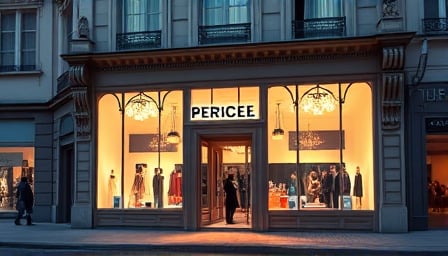Corporate Dynamics at LVMH: Media Expansion, Tax Opposition, and Strategic Alliances
LVMH Moët Hennessy Louis Vuitton SE, under the stewardship of Bernard Arnault, has intensified its presence in France through a series of high‑profile moves that resonate beyond the luxury goods sector. The group’s recent acquisition of the French business magazine Challenges, its vocal stance against a proposed 2 % wealth tax on billionaires, and its partnership with the Global Fashion Agenda collectively illustrate how a premium brand can leverage cultural, demographic, and digital currents to fortify market positioning.
1. Media Acquisition: Bridging Luxury and Information
1.1. Rationale Behind the Purchase
By acquiring Challenges, LVMH extends its reach into the intellectual and entrepreneurial segments of the French population. The magazine’s readership comprises executives, entrepreneurs, and policy influencers—demographics that overlap significantly with the high‑end consumer base for LVMH products. This alignment creates opportunities for nuanced brand storytelling that blends lifestyle content with financial acumen, appealing to a generation that values authenticity and expertise over purely aesthetic appeal.
1.2. Editorial Independence and Consumer Trust
The acquisition has sparked legitimate concerns among Challenges journalists, who warn that editorial independence could be compromised. In an era where consumers are increasingly skeptical of corporate influence, maintaining credibility is paramount. LVMH’s approach to preserving editorial autonomy will be closely watched; a transparent governance framework could serve as a benchmark for other luxury conglomerates considering media investments.
1.3. Digital‑Physical Synergy
Challenges operates both a print edition and a robust digital platform. LVMH can exploit this dual presence to integrate omnichannel experiences—leveraging digital content to drive traffic to physical retail stores, while using in‑store data to inform media content. This cross‑fertilization supports the broader trend of “phygital” retail, wherein the boundary between online and offline consumption is increasingly porous.
2. Opposition to the Wealth Tax: Political Positioning and Investor Perception
2.1. The Tax Proposal
The French government’s plan to impose a 2 % wealth tax on individuals with net assets exceeding €1 billion is framed as a measure to address inequality. LVMH’s opposition, articulated by Arnault as an “ideologically motivated attack,” reflects a broader strategy to safeguard the profitability of high‑margin luxury brands.
2.2. Market Reactions
Investor sentiment has responded predictably. Short‑term volatility in LVMH’s shares indicates sensitivity to regulatory risk. However, the company’s long‑term value proposition—rooted in brand equity, diversified product lines, and global distribution networks—provides a cushion against such policy fluctuations. Analysts suggest that the firm’s ability to absorb incremental costs will preserve its competitive advantage, particularly as luxury consumers shift towards experiential purchases.
2.3. Cultural Resonance
The tax debate dovetails with evolving consumer expectations regarding corporate social responsibility. While some shoppers may view Arnault’s rhetoric as a deterrent, others may interpret it as an assertion of brand autonomy. LVMH’s ability to navigate this dichotomy will influence its positioning among both traditional luxury buyers and younger, socially conscious consumers.
3. Strategic Alliance with the Global Fashion Agenda
3.1. Commitment to Sustainable Fashion
The partnership with the Global Fashion Agenda signals LVMH’s intent to lead in sustainability—a key driver of purchase behavior among Generation Z and Millennials. By collaborating with a platform that sets industry standards for circularity, transparency, and reduced environmental impact, LVMH aligns itself with the cultural shift toward responsible consumption.
3.2. Enhancing Physical Retail Experiences
Sustainability initiatives can be showcased in flagship stores through experiential installations, in‑store recycling stations, and digital interfaces that highlight product provenance. Such integrations create immersive experiences that resonate with a demographic increasingly skeptical of superficial luxury.
3.3. Digital Storytelling Opportunities
The alliance opens avenues for storytelling across LVMH’s digital channels—social media, e‑commerce, and augmented‑reality apps—allowing the conglomerate to narrate the lifecycle of its products. This transparency not only satisfies regulatory scrutiny but also cultivates brand loyalty among consumers who prioritize ethical practices.
4. Forward‑Looking Analysis: Translating Societal Changes into Market Opportunities
| Societal Trend | Consumer Impact | LVMH Opportunity |
|---|---|---|
| Digital‑Physical Blending | Preference for seamless online‑offline journeys | Omnichannel strategies linking Challenges content with in‑store events |
| Generation Z & Millennial Values | Demand for authenticity, sustainability, and social impact | Sustainable product lines, transparent supply chains, CSR storytelling |
| Economic Policy Uncertainty | Heightened sensitivity to tax and regulatory changes | Robust financial planning, diversified markets, value‑added experiences |
| Media Convergence | Shift towards niche, expert‑driven content | Leveraging Challenges platform to reach high‑net‑worth audiences |
Enhanced Data Utilization
The integration of Challenges’ digital readership metrics with in‑store purchase data can refine predictive analytics, enabling LVMH to anticipate shifting preferences and tailor inventory accordingly.Experiential Retail Expansion
By embedding sustainability narratives into physical spaces—through interactive displays that trace a garment’s journey from raw material to finished product—LVMH can convert traditional shopping trips into brand‑reinforcing experiences.Policy‑Resilient Growth Models
Diversifying into emerging markets where fiscal policies differ will mitigate the impact of domestic tax debates, ensuring consistent revenue streams.Thought Leadership in Media
Maintaining editorial independence at Challenges will position LVMH as a steward of quality journalism, thereby reinforcing trust among both consumers and investors.
Conclusion
LVMH’s recent corporate maneuvers reflect a sophisticated response to the intertwined forces of media influence, demographic evolution, and regulatory landscapes. By anchoring its strategy in digital‑physical synergies, sustainable practices, and editorial integrity, the conglomerate not only safeguards its current market dominance but also creates a resilient framework for future growth. The company’s actions serve as a case study for luxury brands seeking to navigate an era where cultural legitimacy, consumer experience, and financial stewardship are increasingly inseparable.
